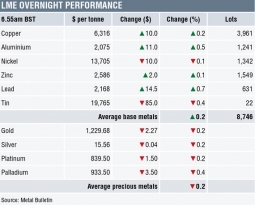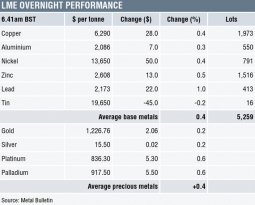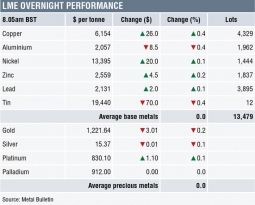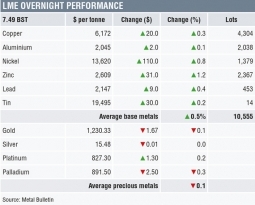The London Metal Exchange (LME), the world’s largest non-ferrous metals market, marked its 139th year of existence by moving to a new HQ in February, although the relocation did not take place without a major hiccup in the summer.
Three years after its purchase by Hong Kong Exchanges and Clearing Ltd (HKEx), the LME upgraded to a purpose-built new HQ on the fringes of London’s financial district – only its fourth location in its entire lifespan.
But the building and its new open-outcry floor at Finsbury Square was closed for nearly two months due to safety issues, resulting in floor traders having to relocate to the LME’s disaster recovery site in the Essex countryside outside London.
During 135 years of independence and since being taken private, the LME has been the premier exchange for the global metal industry; the vast majority of commercial transactions have a price reference discovered on Europe’s last open-outcry trading floor, which is still open for business, even though ring-dealer numbers have fallen to nine firms – there were some 30 in the 1970s heyday.
The LME started life in the 19th century above a City of London hat shop. While the business hub remains in London, its direction has increasingly been guided by China and Asia since its purchase by HKEX.
The following is a chronology of the major events in the LME’s history from its inception to recent developments:
September 2016 – LME says it will implement charge-capping as final component of warehouse reforms package.
August 2016 – LME, World Gold Council and key banks and brokers announce plans to introduce exchange-traded and centrally cleared precious metals products
June 2016 – LME launches electronic ‘Third Wednesday’ programme for member clients
April 2016 – LMEshield, an electronic warehouse receipt system for the global commodities market, is introduced.
February 2016 – LME completes move of offices and new floor to 10 Finsbury Square building
January 2016 – HKEX issues strategic plan for 2016-2018, outlining the development roadmap for it and Hong Kong’s financial markets
November 2015 – LME launches aluminium premium hedging, steel rebar and steel scrap contracts
November 2015 – LME Clear launches two new services: trade compression and the ability to post metals warrants as collateral
October 2015 – HKEx unveils plans to roll out nickel, tin and lead yuan-denominated mini futures contracts in Hong Kong
August 2015 – LME details proposals to enhance liquidity on new contracts and existing products such as market-maker incentives
July 2015 – LME issues consultation on further warehouse reforms
May 2015 – LME calls for consultation on broader access to its electronic trading platform – category three and four members can access system.
March 2015 – LME amends physical delivery procedures and policies and changes warehouse agreement
February 2015 – LME amends order-to-trade ratio for outright trading of monthly forward contracts
January 2015 – LME announces it will move to new premises early in 2016
January 2015 – LME unveils liquidity/participation plan for LMEselect
December 2014 – LME introduces LBMA platinum and palladium
December 2014 – HKEx launches copper, aluminium and zinc mini-sized contacts and thermal coal futures in Hong Kong
September 2014 – LME/HKEx detail fees to apply from January 2015. Average transaction fee rises 34%
September 2014 – LME Clear debuts – clearing, matching and registration all in-house now
September 2014 – LME says will delay introduction of premium hedging contracts until second quarter of 2015
September 2014 – LME Clear receives EMIR authorisation
August 2014 – US judges dismisses aluminium anti-trust lawsuits
August 2014 – Exchange issues first ever commitments of traders report (COTR)
July 2014 – LME appeal against March judgment heard, verdict to come later
June 2014 – LME commits to open-outcry ring remaining open beyond start of 2015
March 2014 – LME delays warehouse changes after UK High Court finds in Rusal’s favour, says proposals are ‘unfair’ and ‘unlawful’
April 2014 – HKEx says will introduce mini-metals contracts and thermal coal futures in Hong Kong
April 2014 – Exchange says will introduce three regional premium hedging contracts.
December 2013 – Russia’s Rusal calls for judicial review over warehouse changes. LME says it will contest
November 2013 – LME introduces package of warehouse reforms
September 2013 – Garry Jones, formerly CEO of NYSE LIFFE, starts as LME CEO and HKEx co-head of global markets
August 2013 – Liz Milan, MD LME Asia, Diarmuid O’Hegarty, LME deputy CEO, and Chris Evans, LME head of business development, resign
August 2013 – US class actions start on impact of warehouse queues on aluminium premiums and prices. HKEx says it will defend vigorously
July 2013 – HKEx/LME launch consultation process on new warehousing rules
June 2013 – HKEx/LME and Bank of China sign deal on renminbi clearing
June 2013 – LME approves Kaohsiung in Taiwan as good delivery point, gets closer to China
June 2013 – Martin Abbott resigns as LME CEO and HKEx co-head of global markets
June 2013 – LME agrees with LCH.Clearnet that clearing will migrate to LME Clear in September 2014
January 2013 – Martin Abbott and Romnesh Lamba appointed as HKEx co-heads of global markets
November 2012 – HKEx acquisition receives formal approval by UK regulator
July 25, 2012 – Shareholders vote to accept the 1.388-billion-pound HKEx bid at an EGM. The deal is set for completion in the fourth quarter of 2012
June 13, 2012 – At historic board meeting, LME receives updated standalone valuation and decides, with one dissenting vote, that a sale should be recommended. The board then unanimously accepts cash offer for entire shareholding from HKEx on the day the latter celebrates its 12th anniversary. Under the offer, LME shares are now worth 107.60 pounds each.
May 2012 – At LME’s regular monthly board meeting, HKEx and ICE are asked to resubmit bids by June 7. They carry out further due diligence and present to LME shareholders.
May 2012 – HKEx, NYSE Euronext, CME Group and ICE place bids by the deadline. All except one increase their bids. Later, the LME board holds an unscheduled meeting to review bids and requests that sale adviser Moelis & Co invite two of the four to a final round
March 2012 – LME sets May 7 deadline for formal binding bids. For any bid to be successful, a 75-percent vote from its 74 shareholders is needed to approve a sale.
February 15, 2012 – Deadline for initial bids, with six parties submitting offers ranging from 900 million pounds to one billion pounds. NYSE Euronext confirms interest. Offers said to be below 800 million pounds are eliminated
November 2011 – JP Morgan buys 600,000 LME ordinary shares at auction at just less than 42 pounds each, which notionally values the exchange at 640 million pounds.
September 2011 – LME reveals that it had received 10 or more expressions of interest with regard to potential bids. Share dealings are suspended. The LME’s share capital comprises 14.85 million ordinary or 10-pence shares and 2.49 million one-penny ‘B’ shares.
September 2011 – Exchange to launch non-ferrous swaps contracts for phone and screen trading in January 2012.
September 2011 – Trevor Spanner appointed managing director of post-trade services. He will take charge of the clearing project
July 2011 – LME review on warehousing concludes – load-out rates will increase from April 2012
May 2011 – LME says it is considering self-clearing, starts consultation process
May 2011 – Plastics futures contracts delisted, warehouse inventories fall to zero.
February 2011 – LME-SGX metal futures start trading in copper, aluminium and zinc. Lead and steel expected by end-2011, tin and nickel will follow.
January 2011 – LME launches Asian reference prices.
November 2010 – LME and LCH.Clearnet will roll out over-the-counter (OTC) gold post-trade clearing service. The launch date is November 29. Contracts to be cleared will be captured via LME’s trade capture system, LMEsmart, with matched bilateral trades submitted to LCH.Clearnet for clearing
August 2010 – Chicago and Detroit selected as further delivery points for the global steel billet contract
July 2010 – The two regional steel contracts – Mediterranean and Far East billet – are merged into a single, global contract
July 2010 – LME and Singapore Exchange (SGX) to develop cash-settled mini monthly metals futures contracts jointly; these will be traded and cleared through SGX
July 2010 – LME officially opens its Asia office in Singapore
June 2010 – New Orleans announced as first US location for delivery of steel billet
April 2010 – Sir Brian Bender appointed new LME chairman
February 2010 – Cobalt and molybdenum start trading
February 2010 – LME submits a formal proposal to bring trading of Forward Freight Agreements (FFAs) on-exchange in a joint venture with The Baltic Exchange
February 2010 – LME chairman Donald Brydon announces intention to stand down
November 2009 – MMTA members vote to reject OPDS system
September 2009 – Proposals to revamp corporate governance rejected at EGM
September 2009 – LME and MMTA announce they are studying setting up an online price discovery system (OPDS) for some minor metals
August 2009 – Cobalt and molybdenum contracts launch date confirmed as February 22, 2010
July 2009 – LME proposes the formation of a new joint venture with shipbroker sector for freight forward contracts, tentatively called the London Baltic Freight Exchange.
July 2009 – LME says holding talks with participants in the OTC freight market with a view to introducing on-exchange forward freight contracts.
July 2009 – Smart (System for Matching and Registering Trades) introduced. This decouples matching from LCH.Clearnet, which has handled this function in tandem with clearing for 22 years
July 2009 – Consultation on plastics trading completed. Contracts will cease trading on the floor in February 2010, with settlement prices reached electronically
April 2009 – LME pays first ever dividend to ordinary shareholders and drops rebate paid to members based on volumes
January 2009 – LME sets up liaison group with Minor Metals Trade Association (MMTA)
September 2008 – Forward contract extensions go live
September 2008 – Exchange says it will introduce contracts for cobalt and molybdenum in the second half of 2009, with trading on all three platforms out to 15 months. The date is subsequently put back because infrastructure systems are delayed
July 2008 – Spot trading starts in steel billet, concluding contract launch process
May 2008 – Further enhancements made to plastics contracts, including the removal of warrant shelf-life
April 2008 – Steel billet futures ‘hard launch’ – open-outcry ring trading starts
March 2008 – Cleared average price swaps trading starts
February 2008 – Steel billet trading starts with ‘soft launch’
January 2008 – LME says it will extend prompt dates for primary aluminium, copper, zinc, nickel and lead futures contracts.
September 2007 – LME says ‘soft launch’ of steel contracts on Select and inter-office phone market will be on February 25, 2008
June 2007 – Plastics futures revamped, with regional contracts and prompt dates launched
June 2007 – LME says it will start trading in two physical steel billet contracts on April 28, 2008
December 2006 – LME introduces mini five-tonne contracts in copper, aluminium and zinc
September 2005 – First plastics futures contracts become deliverable
May 2005 – Exchange launches futures contracts for two plastics – linear low-density polyethylene and (LL) and polypropylene (PP)
April 2005 – LME starts publishing prices and volumes for matched trades in ring, kerb and inter-office trade
July 2004 – Exchange sets May 27, 2005 as launch date for two plastics futures contracts – the first non-metallic instruments in its history
March 2002 – Silver contract suspended. North American Aluminium alloy contract introduced
February 2001 – Electronic trading platform LME Select introduced
September 2000 – LME demutualised
April 2000 – LMEX index contract launched
May 1999 – Revamped silver contract launched
June 1996 – Sumitomo Corp head trader Yasuo Hamanaka plunges market into crisis after losing $2.6 billion on copper over a 10-year period
1994 – LME moves to Leadenhall Street
1993 – Copper and lead trade redenominated in dollars from sterling
October 1992 – Aluminium alloy contract introduced
1991 – Maximum length of copper, nickel, aluminium and zinc contracts extended to 27 months from 15 months. US warehouses registered
1989 – LME launches Vendor Feed System (VFS), its first electronic pricing system. Tin contract is brought back, denominated in dollars. Japan warehouses registered
1988 – Traded options for metals introduced. Previously, non-transferable options had been transacted. In September, nickel and zinc trading switches to dollars from sterling
1987 – Singapore warehouses registered
1985 – Tin crisis – prices tumble after the International Tin Council’s buffer stocks collapse. Contract suspended
September 1980 – LME moves to Plantation House, Fenchurch Street
April 1979 – Nickel contract introduced
December 1978 – Standard aluminium contract introduced
1960 – LME has registered warehouses in 10 UK cities
October 1952 – The exchange reopens following the Second World War
1941 – Tin trade halts when Japan enters the war
1939 – Copper, lead and zinc trading on LME halts at outbreak of the Second World War when the UK government takes over the purchase and stocking of metals
1920s – Pig iron contract suspended
1915 – Zinc contract officially launched
July 1914 – LME closes because of fear of supply shortages at the outbreak of the First World War. It reopens in autumn of the same year
1903 – Lead contract introduced
1882 – The exchange moves to purpose-built premises in Whittington Avenue
1877 – The London Metal Market and Exchange Company established above a hat shop in Lombard Court. It trades in tin, copper and pig iron
(Editing by Mark Shaw)
The post History of the LME: teething problems mar move to new HQ appeared first on The Bullion Desk.
Read More
Source: Bullion Desk News








